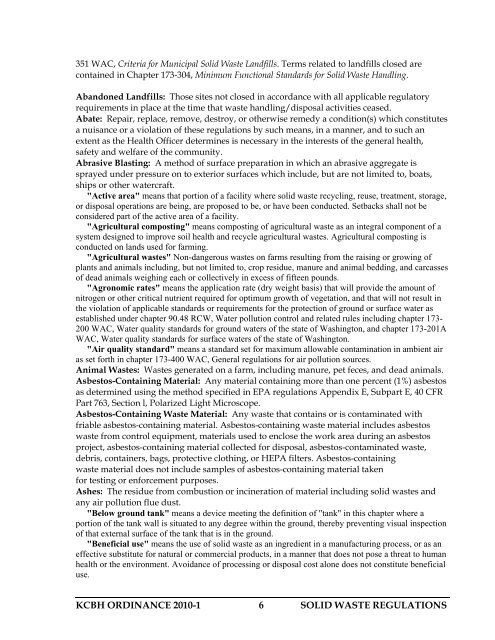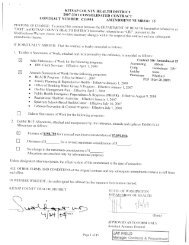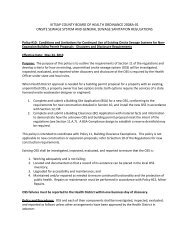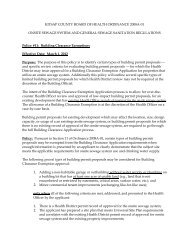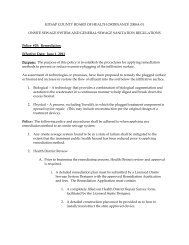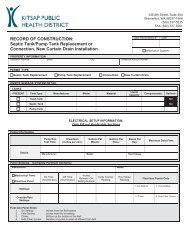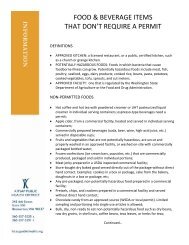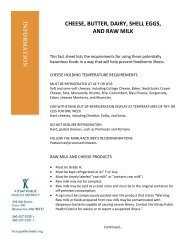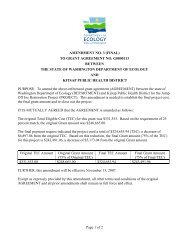SOLID WASTE REGULATIONS - Kitsap Public Health District
SOLID WASTE REGULATIONS - Kitsap Public Health District
SOLID WASTE REGULATIONS - Kitsap Public Health District
You also want an ePaper? Increase the reach of your titles
YUMPU automatically turns print PDFs into web optimized ePapers that Google loves.
351 WAC, Criteria for Municipal Solid Waste Landfills. Terms related to landfills closed are<br />
contained in Chapter 173-304, Minimum Functional Standards for Solid Waste Handling.<br />
Abandoned Landfills: Those sites not closed in accordance with all applicable regulatory<br />
requirements in place at the time that waste handling/disposal activities ceased.<br />
Abate: Repair, replace, remove, destroy, or otherwise remedy a condition(s) which constitutes<br />
a nuisance or a violation of these regulations by such means, in a manner, and to such an<br />
extent as the <strong>Health</strong> Officer determines is necessary in the interests of the general health,<br />
safety and welfare of the community.<br />
Abrasive Blasting: A method of surface preparation in which an abrasive aggregate is<br />
sprayed under pressure on to exterior surfaces which include, but are not limited to, boats,<br />
ships or other watercraft.<br />
"Active area" means that portion of a facility where solid waste recycling, reuse, treatment, storage,<br />
or disposal operations are being, are proposed to be, or have been conducted. Setbacks shall not be<br />
considered part of the active area of a facility.<br />
"Agricultural composting" means composting of agricultural waste as an integral component of a<br />
system designed to improve soil health and recycle agricultural wastes. Agricultural composting is<br />
conducted on lands used for farming.<br />
"Agricultural wastes" Non-dangerous wastes on farms resulting from the raising or growing of<br />
plants and animals including, but not limited to, crop residue, manure and animal bedding, and carcasses<br />
of dead animals weighing each or collectively in excess of fifteen pounds.<br />
"Agronomic rates" means the application rate (dry weight basis) that will provide the amount of<br />
nitrogen or other critical nutrient required for optimum growth of vegetation, and that will not result in<br />
the violation of applicable standards or requirements for the protection of ground or surface water as<br />
established under chapter 90.48 RCW, Water pollution control and related rules including chapter 173-<br />
200 WAC, Water quality standards for ground waters of the state of Washington, and chapter 173-201A<br />
WAC, Water quality standards for surface waters of the state of Washington.<br />
"Air quality standard" means a standard set for maximum allowable contamination in ambient air<br />
as set forth in chapter 173-400 WAC, General regulations for air pollution sources.<br />
Animal Wastes: Wastes generated on a farm, including manure, pet feces, and dead animals.<br />
Asbestos-Containing Material: Any material containing more than one percent (1%) asbestos<br />
as determined using the method specified in EPA regulations Appendix E, Subpart E, 40 CFR<br />
Part 763, Section l, Polarized Light Microscope.<br />
Asbestos-Containing Waste Material: Any waste that contains or is contaminated with<br />
friable asbestos-containing material. Asbestos-containing waste material includes asbestos<br />
waste from control equipment, materials used to enclose the work area during an asbestos<br />
project, asbestos-containing material collected for disposal, asbestos-contaminated waste,<br />
debris, containers, bags, protective clothing, or HEPA filters. Asbestos-containing<br />
waste material does not include samples of asbestos-containing material taken<br />
for testing or enforcement purposes.<br />
Ashes: The residue from combustion or incineration of material including solid wastes and<br />
any air pollution flue dust.<br />
"Below ground tank" means a device meeting the definition of "tank" in this chapter where a<br />
portion of the tank wall is situated to any degree within the ground, thereby preventing visual inspection<br />
of that external surface of the tank that is in the ground.<br />
"Beneficial use" means the use of solid waste as an ingredient in a manufacturing process, or as an<br />
effective substitute for natural or commercial products, in a manner that does not pose a threat to human<br />
health or the environment. Avoidance of processing or disposal cost alone does not constitute beneficial<br />
use.<br />
KCBH ORDINANCE 2010-1 6 <strong>SOLID</strong> <strong>WASTE</strong> <strong>REGULATIONS</strong>


